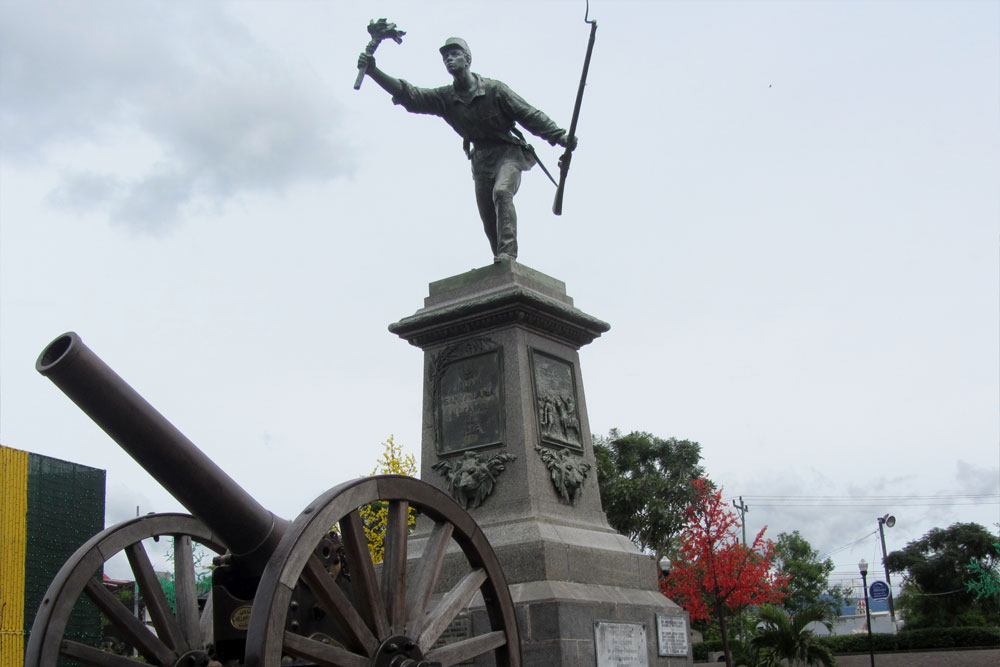
Juan Santamaría burned called Mesón de Guerra, an act that allowed the Costa Ricans beat the filibusters of William Walker and stay with the city of Rivas in his possession.
First Battle of Rivas, the best known historically occurred on April 11, 1856. After the Battle of Santa Rosa and head of the president Juan Rafael Mora, Rivas left the troops to 25,000 men. On their way to Rivas took the port of San Juan del Sur on the Pacific and the Virgin Mary in Lake Nicaragua. On April 8, Mora and his men arrived in Rivas, where the head of the battalion defense Byron Cole decided to retire. William Walker attacked the headquarters of the General Staff of our army, but Jose Maria Rojas, and Francisco Rodriguez spoke bravely to repel the attack.
In morning hours of April 11, 1856 our compatriots were surprised by the enemy battalion. This caused confusion and disorientation of our fellow citizens, but the counterattack was launched with great courage. Most of the enemy forces concentrated in a guesthouse called Mesón casona owned by Francisco Guerra. Well positioned in the inn, the filibusters will be very easy to control the situation, giving the warning shot against us.
The battle lasted several hours, with heavy casualties on both sides. Costa Rican 500 low and 200 to 250 in the army filibuster, according to Ivan Molina recounts in his book "The National Campaign 1856-1857."
According Jerónimo Pérez, combat locks in a horrible and disadvantages of the Costa Rica because it took to chest bare to evict the opponents of the house they occupied, from whose roofs were ravaging them. But the stronger was the heroism and courage of our officers and soldiers, who were motivated by the president Juan Rafael Mora Porras in person.
With all these reasons Costa Ricans took the offensive in the battle and the General Cañas exclaimed: "Boys, do not be among so many brave one who wants to risk their lives, burning the Mesón to save their compatriots." The soldier replied Juan Santamaría in the act: "I will go: but I charge to my mother." She was immediately improvise a firebrand, left for the race and applied it to the southwest wing of the inn, was shot in his right arm, but always had the opportunity to burn the inn, he fell to the ground watching the sky, in the belief that his work had been accomplished.
This is how the buccaneers did not achieve their target and fled the restaurant. After taking the city, the Costa Rican army had planned to secure control over the first port of Rivas and La Virgen and San Juan del Sur, and later attacking Granada. However, these plans were foiled by the arrival of a cholera epidemic, which would force them to return to Costa Rica, where the disease has claimed nearly 10,000 victims (nearly 10% of the population at that time). Mora and his brother José Joaquín José María Cañas left in command of troops in Costa Rica. The campaign would be suspended until next year when the campaign resumed with the Traffic Way, which aims to cut supplies to filibusters through the San Juan River, border between the two countries, which eventually determine the final victory of the Central American invaders.
Second Battle of Rivas
In the second battle of Rivas, which took place on April 11, 1857, the combined forces of the five Central American countries, Costa Rica led by General José Joaquín Mora Porras, tried to seize the city, where troops were filibusters led Walker personally. After four hours of fighting, the Central American forces had to retreat with a large number of casualties, before the heavy fire of the buccaneers.
Despite that victory was a filibuster, the second battle of Rivas was the last major battle of the campaign since the May 10, 1857 Walker surrendered to the American captain Charles Davis, whose Saint Mary’s ship was anchored San Juan del Sur. General Mora accepted the capitulation, and Walker left the Central American territory.
Juan Santamaría
A hero to the Motherland
Born in 1831, in Alajuela, son of Manuela Santamaría, is said to have been an only child. Characterized according to several authors, as a young man, humble, hardworking, cheerful and brave. He died in 1856 at the age of 25 years.
Enlist in the troops were commanded by a brave military called José María Cañas, El Salvador and of holding the rank of General in charge of the drum to mark the passage of the peasants who made up the troops alajuelenses. His name became history, the decisive confrontation of the campaign of 1856. The act of killing of Juan Santamaría consisted in making the tea, how brave to burn in the inn of war. This frees us from the filibusters and slavery, ending with the aspirations of William Walker who was entrenched with his troops in the inn.
Recognize a hero Juan Santamaría, the initiative comes from the Panamanian José Obaldia in the year 1861. Recognize the heroism of Juan Santamaría, not only to acknowledge their courage, for his act itself, but represents many heroes who fell as he offered his life for the freedom of their homeland.
In Alajuela, a park and a bronze statue dedicated to the memory of Juan Santamaría, with two guns of the era. Also in this park, there are 7 boards on which were written the names of some of the brave men who died in the battle of 1856. The statue was unveiled on 15 September 1891 by José Joaquín Rodríguez, president of the Republic.

 English
English






